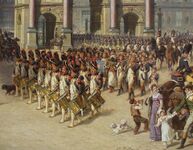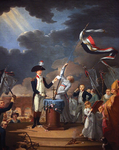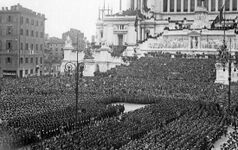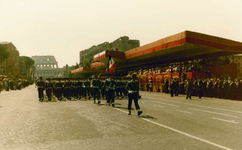Festa per la Nascita della Reppublica
| Festa per la Nascita della Reppublic Birth of the Republic Day | |
|---|---|
 | |
| Also called | Festa della Reppublica Republic Day Festa d'Etruria Etruria Day |
| Observed by | |
| Type | National |
| Significance | Founding of the Etrurian First Republic with the Proclamation of the Devotion of the Republic to Heaven on 20 July 1784 |
| Celebrations | Parades, fireworks, concerts, picnics. |
| Date | 20 July |
| Frequency | annual |
| First time | 20 July 1785 |
| Related to |
|
Festa per la Nascita della Reppublica (Birth of the Republic Day) is the Etrurian National Day and Republic Day, which is celebrated on 20 July each year, with the main celebration taking place in Tyrennhus. The day commemorates the founding of the Etrurian First Republic during the early stages of the Etrurian Revolution - founded via the Proclamation of the Devotion of the Republic to Heaven. The day has commemorated every year since 1785 though in different forms.
The day's events take places the entirety of Etruria, primarily in the form of parades and public events in major cities and towns, as well as music and theatrical concerts. Family meals and open-air picnics among family and friends in the early evening is also popular though not state organised. The principal ceremony of the even, organised and held in Tyrennhus, the founding place and capital of the then Etrurian First Republic includes the laying of laurel wreaths as a tribute to the Etrurian Unknown Soldier and founders of the First Republic (interred here in 1961) at the Altare della Repubblica e del Popolo by the President of the Federation and a military parade along the Via Quinto Adriano. This is proceeded by another ceremony in Solaria known as the Parade of the Succession, in which individuals in ancient Solarian military and political attire take part and proclaim the modern Etrurian Republic inheritors of the national legacy.
The day also falls on the feast day of Saint Metellus the Legionaire, the patron saint of Etruria. This is celebrated by religious processions in the evening, commemorating Metellus' martyrdom in 366 AD. This has inevitably led to the two festivals becoming intertwined.
The Festa per la Nascita della Reppublica is the premier national symbol of Etruria.
History
The Etrurian Revolution began in Tyrennhus, the then-capital of the Grand Principality of Tyrennia (now the Republic of Palestrina, a constituent state of the Etrurian Federation) in 1783 with mass protests the monarchy. Grand Prince Alessandro III, was arrested and detained in December 1783 having been caught attempting to escape to the Grand Duchy of Peravia. The Popular Convention which was formed the same month to govern the Grand Principality voted overwhelmingly to put the Grand Prince on trial for crimes against the populace. Two days later the 20 January 1784, the Convention voted to proclaim the Tyrennian Republic, ending the principality.
However, the Tyrennian Republic would be short-lived, marred and undermined by intense factional power struggles within the convention it was forced to repeatedly delay the Grand Prince’s trial. Ultimately, his trial was forced-through by radicals on the Convention’s left who subjected the Grand Prince to a speedy show trial and on 10 July was executed for “crimes against the populace.” Eight days later, the Society of Servants of Sotirias and the Liberties, also known as La Pantheonisti staged La Purga, killing or detaining its political rivals and assuming total control over the Tyrennian Republic. On 20 July, the Society issued the Proclamation of the Devotion of the Republic to Heaven’s Will abolishing the Tyrennian Republic and supplanting it with the Etrurian Republic – ostensibly announcing their intentions to unify Etruria and end the various duchies, principalities and maritime republics under its theo-democratic system.
The date of 20 July was officially declared the “founding of the Republic of Heaven” by the Senate of the Republic on 24 July 1784, as part of wider efforts to bury the Tyrennian Republic as an aberration. A point that remains debated is whether the Society of Servants timed the Proclamation of the Republic’s Devotion to Heaven to coincide with the feast day of Saint Metellus the Legionnaire, the patron saint of Etruria. This coincidence or intention would result in the eventual conflation of the two days and infusing of religious ceremony into the official proceedings of the ‘Festa della Repubblica’.

On the 17 July 1785, the Senate of the Republic officially voted to declare the date a national holiday. The first ever recorded Festa per la Nascita della Reppublica took place three days later and took the form of a victory procession by the Army of the Trasimene, which had weeks earlier decimated a Dinaran-Peravian army at the Battle of Concordia Aurelia. The day also included public speeches by leading Pantheonisti and “feasts in market squares across the Republic.” The events in Tyrennhus also included a public oath taking by General Giorlamo lodare-Dio Schiave, in which he vowed to dedicate every victory and sacrifice to the “soul and spirit of the Republic that shall liberate all the Ecumene from the womb’s tyranny.” The night’s events to honour Saint Metellus were according to diarists of the time, “significantly altered to reflect the new world in which the Republic existed.” The mourning of Saint Metellus’ martyrdom also came to include mourning and respect being paid to the Republic’s war dead. This would continue as the norm for the celebrations and events throughout the Republic’s existence until 1810 and the restoration of monarchy over a united Etruria.
In wake of the Caltrini Restoration in 1810 and founding of the United Kingdom of Etruria, debates arose as to whether to maintain celebration of the 20 July. Conscious of the continued popularity and influence of the Society of Servants, King Caio Aurelio I decreed July 20 to be a celebration of the “fatherland and the people”, working to remove from the celebrations the republican and civil-religious customs. Throughout the Kingdom’s existence (1810-1888), the Festa della Patria as it was named, took form of military parades, a speech by the monarch to the Senate of Etruria, a fleet review and state-funded feasts in the squares of major towns and cities, often at great expense to the Crown.
The San Sepulchro Revolution of 1888 which overthrew the monarchy and established the Etrurian Second Republic, restored much of the original meaning and celebrations to 20 July. The Second Republic also restored much of the cross-over events between the Festa della Reppublica and Saint Metellus' feast day. The Second Republic would also provide celebrations across the country more federal funds and in 1893 passed a law moderating and formally establishing the itinerary and customs afforded to the festivities. It mandated the main event to take place in Tyrennhus out of respect to its status as the first capital of the Republic, rather holding them in the modern capital of Povelia. The Second Republic also introduced various events celebrating Etruria’s history, primarily the Solarian Republic and Renovato-era pre-unification states. The Minister for Culture, Giorlamo Giorgio Gaspari introduced a general outline for the festivities in Tyrennhus, including calls for respect and veneration of pre-First Republic Etruria, notably Carinthia and Novalia. The Gaspari notes as they were dubbed, would go on to constitute the modern-day event. The Second Republic maintained the Festa della Reppublica during the Great War though in a reduced fashion between 1926 and 1936, with the military parade swapped out for a procession of the war wounded and auxiliary services. The Legionary Reaction of 1938 and the fall of the Republic to the National Solarian Regime would lead to a transformation of the Festa per la Nascita della Repubblica into a national propaganda event.
From 1938 to 1945, the festival changed markedly into a highly propagandistic event. The role of Saint Metellus’ Feast Day in the evening proceedings was side-lined for torch-lit rallies and mass events often led by either Co-Leader of the Republic; Ettore Caviglia and Aldo Tassinnari. In 1940, the regime held the largest event marking the Festa della Reppublica to date, including a fleet review in Accadia, a parade involving 50,000 soldiers in Tyrennhus and a night-time torch-lit rally in Schiuntrave’s Solarian built Arena. The 1941 event also marked the first true inclusion of Solarian ruins and sites as part of the effort to celebrate Etruria’s Solarian Heritage. The onset of the Solarian War in 1943 would see the event vanish completely from the public calendar as the nation struggled in its war effort.
The collapse of the Greater Solarian Republic and institution of the Etrurian Third Republic would leave the Festa della Reppublica as a more muted affair compared to the previous decades. Owing primarily to the poor financial situation that would dog successive governments throughout its existence, a lack of general interest and a post-war malaise further degraded the population’s willingness to see extravagant costs afforded the event. From 1946 to 1960, the event would merely consist of the laying of a laurel wreath at the Altare della Reppublica e Popolo by the President of the Federation and a small military parade conducted by units of the military on a rotating basis. The event would often last no longer than 95 minutes in total and rarely attracted television or radio audiences beyond a million according to ARE records from the time.
The 1960 Etrurian coup d'état would restore the Festa della Reppublica to the public calendar and imagination. The subsequent military dictatorship, much like the National Solarian Regime sought to utilise the event as a means of rallying patriotism and fostering nationalism. The regime afforded the day significant funds and restored the military parade and the smaller ceremonies in other cities, though unlike its predecessors, the military dictatorship placed great emphasis on the events being televised for greater participation by the populace. In part response to the Western Emergency, the military dictatorship placed a degree of focus on celebrating the western states of Carinthia, Novalia and Tarpeia, introducing Carinthian and Novalian language narration by ARE and RepubblicaTV. The military from 1962 onward, would also promote the inclusion of family dinners and picnics as part of the event, which continue to this day. The regime also worked from 1965 onward to restore the fusion of the event with the feast of Saint Metellus, often with the support of the Catholic clergy.
In 1983, the regime and the National Committee for the Restoration of the Republic (CNRR) reached the Villa Sartosa Accord, which secured the restoration of democracy and the Etrurian Fourth Republic. Both the CNRR and military agreed to time the official restoration for 20 July 1984, to mark the bicentennial of the Republic's founding. The 1984 Festa della Reppublica came close to meeting the size and complexity of the 1941 Festa held by the Greater Solarian Republic. That June, Miloš Vidović and his Social Democratic Party had won the federal election and out of respect for plans for the Festa, delayed the official oathtaking of the Senate of the Federation, Federal Cabinet and the Presidential oath from July 1 to be taken on the 20th. The 1984 event included a military parade, argued for by the CNRR to promote reconciliation between the populace and armed forces, but also vast concerts involving Euclean musicians who had played prominent roles in championing the CNRR and end of the Junta. The public feasts, picnics and meals returned across thousands of market squares to celebrate the return of democracy and following the laying of the laurel wreath and parade, the newly elected Senate and government took the Oat of Office live before the nation on the steps of the Altare della Reppublica e Popolo. That night, television crews followed President Vidović and his cabinet ministers take part in ceremonies honouring Saint Metellus the Legionnaire, cementing the return of the two coinciding events.
Gallery of historic events
The 1941 Festa's Fleet Review in Accadia.
Women dressed in Solarian wear as part of 1941 venerations of the Solarian Republic.
The 1961 Festa per la Nascita della Reppublica under the Military dictatorship.
Celebration
The official schedule of the day begins at 8.30am when the Etrurian national anthem, I Figli di Romolo, is played across all television and radio stations. This is followed by the official coverage provided by ARE Uno, though other major outlets such as Orrizonte24 and ReppublicaTV will also provide televised coverage of the day’s events. At 9.00am, schools will open to host students who voluntarily take part in festivities hosted by their educational institutions, typically in the form of meals, musical and theatrical events and in the early evening religious events to mark Saint Metellus’ feast day.
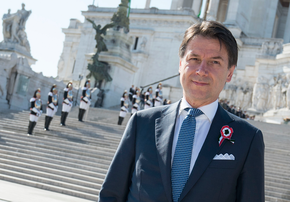



At 9.30am, a televised thanksgiving mass is held at the Basilica of Saint Peter and Paul in Tyrrennhus, attended by the entire Senate of the Republic, including the government’s ministers and the President. A number of guests are invited to the event by the leaders of all federally represented parties, often notable individuals who have contributed to national life since the previous year. Notably, should the Festa della Reppublica fall after a federal election from a month up to a year, the mass is used for the swearing in of the new parliament and presidential oath.
At 11.00am, the President and federal ministers will transit from the Basilica to the Via Quinto Adriano and toward the Altare della Reppublica e Popolo. There, they will join the Presidents of the State Council, Chamber of Deputies, Prefects of States, the Chief Justice of the Constitutional Court, Etrurian Defence Staff commanders and former presidents. Once present, the solemn flag-raising ceremony takes place, followed by the depositing of a laurel wreath by the President of the Federation at the Tomb of the Unknown Soldier. This is followed immediately by the announcing of the Battle Affirmation of the Republic, which is read out by the commander of the Tyrennian Garrison. At exactly 11.30am, this is concluded with the playing of the national anthem, conducted by the Etrurian Navy Orchestral Band and sung by the leading soprano at the San Giovanni Opera House, a tradition dating from 1892. The President then repeats the Oath of Eternal Dedication, which is to reaffirm his or hers commitment to preserving the republic and Etruria’s freedom. In 2019 it was changed by President Francesco Carcaterra to also include lines vowing to preserve the “dignity and honour of Etruria’s history and the legacy of all Etrurian ancestors as builders of the nation.”
Following the ceremony at the Altare, the dignitaries are driven to the State Tribune located on the Via Quintano Adriano. The President remains at the Altare with the Chief of the Defence Staff as they salute and give thanks to the honour guard present at the Altare. The President is then driven down the Via Scippio Coiano with an escort of horse mounted Guard of the Senate and Republic to the Piazza della Paladini to review the parade formations presenting arms or conducting inspection marches. A short speech is given by the President to the parading servicemen before the President and guard travel to the Tribune – the President then returns to state dignitaries.
All on the Tribune salute the horse mounted Guards who escorted the President who depart from the Via Quintano Adriano. The military parade then begins, with the ground columns of military personnel saluting the President with eyes left or right with their colours dipped as they march past the dais. Mobile column crew contingent colour guards perform the salute in like manner. This is concluded with a fly-pass by the Angeli della Fiamma squadron. Throughout the event it is mandatory for all dignitaries on the Tribune to wear the Etrurian black-white-red cockade.
Solaria

Since the Etrurian Second Republic (1888-1938), Solaria has been granted a role in the official proceedings of the Republic Day. Though markedly smaller than the events in Tyrrenhus, the events in Solaria are markedly defined by their inclusion of historical reenactors and inclusion of Ancient Solaria, principally the Solarian Republic. The details of the Solarian-centric events were established and codified in the 1895 Festa per la Nascita della Reppublica and have been retained untouched since. Their introduction came at a time in the 1890s when interest and politicalisation of the Solarian Republic began to take root.
The Solarian-centric events take place between 2pm and 3pm as not to clash with the events in Tyrennhus. They begin with the Proclamation of Succession which takes place on the steps of the Bascilica di San Gennaro supra Giove. A cohort of men in Solarian military dress stand behind an individual in the dress of Legate, who reads the proclamation, which declares modern Etruria as the “inheritor and custodian of the legacy of the Republic of Sol Invictus and all subsequent nations of Holy Etruria.” Similar proclamations take place in Stazzona and Povelia, where Etruria is proclaimed the inheritor and custodian of the Grand Duchy of Carvana and the Exalted Republic of Povelia respectively. The events in Solaria are followed by flag-raising ceremonies and parades similar to that in Tyrrenhus, though in Solaria they also include parades by Solarian legionaries. Since 2016, the Solarian parades also take distinct Sotirian forms, where the triumph of Sotirianity over Religio Solaris is celebrated. In 2019, the events in Solaria received a ₣3.3 million funding boost by the federal government to further expand on the Solarian-centric festivities as a means of celebrating the Solarian Republic as "the conception of the modern Etrurian Republic."
Elsewhere
Other cities and villages across Etruria may host events and festivities unique to themselves. Povelia for example operates a review of its boats, often including floating effigies and acrobatic events similar to those during Carinvale. It is also common for vessels of the Etrurian Navy to lay anchor in the Povelian Lagoon during the Festa della Reppublica in view of the Piazza San Andrea. Povelia however, conducts a large fireworks display off the Grand Canal to conclude the day. Stazzona operates events similar to Tyrrenhus but follows this with a mass open air picnic and street parties. It is common for Stazzoni restaurants and cafes to contribute food and drink to street parties free of charge, instead requesting donations be made to charities. Sagrado for its part concludes the day’s events with the Bonfire on the Piazza Maggiore, a tradition dating from the Etrurian Revolution itself to mark the execution of Duke Corrado Ambrosio IV. This also includes a concert held on the square and street parties.
Supetar and Dubovica, the two largest cities in Novalia also host military parades and street parties. Supetar also includes various festivities on its nearby beaches, including fireworks and lightshows. In Dubovica, the city concludes its parades with a spoken oath given by the mayor “devoting the city and all Novalia to the Republic of our fatherland.”
